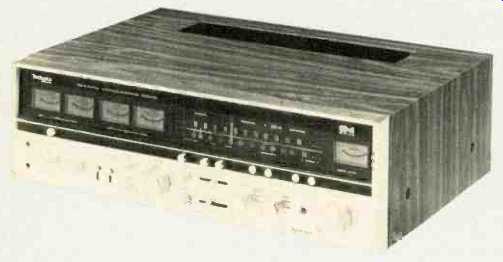 .
.
MANUFACTURER'S SPECIFICATIONS
FM Tuner Section:
Sensitivity (IHF): 1.9 µ V.
S/N: 65 dB.
Selectivity: 65 dB.
THD: Mono, 0.3%; Stereo, 0.4%.
Capture Ratio: 1.8 dB.
Frequency Response: 20 Hz to 13 kHz ±1 dB.
Image Rejection: 55 dB.
I.F. Rejection: 60 dB.
Spurious Rejection: 60 dB.
AM Suppression: 50 dB.
Stereo FM Separation: 1 kHz, 40 dB.
AM Tuner Section:
Sensitivity: 20µV (external antenna). Selectivity: 25 dB.
Image Rejection: 40 dB. I.F. Rejection: 40 dB.
Amplifier Section:
Continuous Power Output: 13 W x 4 or 36 W x 2, 8 ohms, 20 Hz to 20 kHz, (16 W and 42 W respectively at 1 kHz). Rated THD: 0.5%. Rated IM: 0.7%.
Power Bandwidth: 5 Hz to 40 kHz.
Frequency Response: 10 Hz to 50 kHz,+0,-3 dB.
Input Sensitivity: Phono, 1.5 mV; Aux, 150 mV; Mic, 2 mV.
Damping Factor: 30@8 ohms.
Residual Hum and Noise: Phono (IHF "A"), 70 dB; Aux, 90 dB.
Tone Control Range: Bass, ±13 dB 159 Hz; Treble, ±10 dB @10 kHz.
General Specifications:
Maximum Power Consumption: 200 watts at 120 V, 60 Hz.
Dimensions: 19 1/2 in. W x 6 3/8 in. H x 15 3/4 in. D.
Weight: 29 lbs., 6 oz.
Price: $549.95.
There are two ways of looking at a 4-channel/2-channel receiver such as the Technics SA-8000X. One can view it as a fairly powerful stereo receiver and judge it in the light of more conventional stereo all-in-ones in the same price class. Alternatively, one can judge it as a full-fledged quadraphonic receiver having relatively low power output per channel but equipped with just about every 4-channel control and decoding facility one might possibly want in this era of multiple system quad. Either way, this entry from Technics comes out ahead on nearly every count.
Since Panasonic chose to support the CD-4 disc quite early in the short history of 4-channel sound, it is no surprise to find the receiver fully equipped with the demodulator circuitry necessary for playing these "discrete" discs. Matrix discs can be played through the system as well and, though there is none of the advanced "logic" circuitry now finding its way into some separate matrix decoders and a few all-in-one receivers.
The upper dial area of the receiver contains the usual AM and FM dial scales, a signal-strength meter, four illuminated VU level meters, and a variety of individually illuminated function and mode indicators, including the usual FM stereo light and a "Radar" light which illuminates when a CD-4 record is played. Along the black center-line of the panel are the power switch, a meter-sensitivity push button (which increases meter sensitivity by 10 dB, making them useful at any listening level), a pair of tape monitor push buttons, and four miniature knurled gold knobs used to adjust the CD-4 demodulator circuitry when first installing a new CD-4 cartridge. Since these adjustments need to be performed only during setup, we would have preferred to see them located on the rear panel which might discourage their unauthorized rotation by inquisitive small hands and fingers.
The lower, gold section of the panel contains head phone jacks for stereo or quadraphonic phones, bass and treble controls (operative for all channels at once), 4 individual-channel level controls flanking a master volume control, a pair of slide controls which alter matrix decode parameters, a mode switch (with positions for mono, stereo, a pair of matrix phase settings, and a discrete setting), the program selector knob, and a good sized tuning knob coupled to an effective and smooth flywheel and tuning dial assembly. A phone jack adjacent to the tuning knob accepts a low to medium impedance microphone.
This last feature is virtually worthless, since the micro phone cannot be used in a "mix" with any other program source nor are there provisions for a stereo pair of mics.
Anyone desiring a mono P.A. system would not look to an elaborate 4-channel receiver such as the SA-8000X in the first place! The rear panel layout shown in Fig. 1 includes the usual input, tape in and tape out phono tip jacks (provision is made for two 4-channel tape decks), 75-ohm, 300-ohm FM and external AM antenna terminals, switched and unswitched convenience a.c. receptacles, and a grounding terminal. Arrangements specifically related to the 4-channel functions of the unit include a three-position slide switch used to calibrate those front-panel separation and carrier adjust controls associated with CD-4 record playing, and a 3-position cartridge selector which permits the use of some of the new semi-conductor cartridges by supplying polarizing voltage for these devices right at the phono jacks. A third position on this switch is intended for use with conventional magnetic cartridges, whether they be stereo or CD-4 types. The speaker terminals are somewhat confusingly labeled (for that matter, the user would be well advised to read the entire instruction manual before starting to hook up this receiver, as with any new piece of gear, and to re-read the hook-up steps as they are performed), in that a stereo speaker arrangement must be hooked up differently from a 4-speaker quadra-phonic array. In one case, all the red terminals are used, while in the other case red and black pairs are used for each of the four speaker systems. Besides this reconnection requirement (when converting from 2-speaker to 4-speaker use), an adjacent switch must be thrown from 2-ch to 4-ch (or the other way) in order to alter internal circuitry to what Technics calls "BTL" (Balanced Transformerless) operation and what we, here, generally term "strapping" or "bridging." A 4-channel FM detector output jack is also provided on the rear panel (for the discrete 4-channel FM broadcast system still to be selected by the FCC some day), and there is a multi-pin socket intended for a "joystick" remote control 4-channel balancing accessory which was not tested.
Four speaker line fuses complete the rear panel layout. It should be noted that when using the receiver in the stereo mode, speaker impedance is restricted to 8- or 16-ohms, while in quadraphonic applications, speakers may have impedances of from 4 to 16 ohms.
An internal view of the chassis of the SA-8000X is pictured in Fig. 2. The FM front-end uses a 4-pole MOS-FET for an r.f. amplifier, and tuning is accomplished by means of a frequency-linear variable capacitor. The i.f. section has five stages, including three differential amplifier stages and band-pass characteristics are largely determined by three dual-element ceramic filters which require no alignment. Most of the functions of the stereo FM de coding circuit are performed by a single monolithic IC which incorporates two differential switching circuits.
The phono equalizer preamp section is a two-stage direct-coupled circuit which uses a combination of low-noise PNP and NPN transistors. Tone controls are of the negative feedback type. The power amplifier section features a differential amplifier input and direct-coupled circuitry right up to the speaker output connection points.
In the two-channel mode, amplifier sections are paralleled using the now accepted "strapping" technique which places "chassis ground" effectively at the mid-points of the speaker loads. "Common ground" speaker connections are therefore not possible-a condition that is true with most 4-channel/2-channel receivers of recent vintage. The AM section of the receiver, unlike most, also utilizes a frequency-linear, variable capacitor which results in even spacing of the dial calibration from low end to high end and makes station selection somewhat easier. A ceramic filter is used in the AM i.f. section.
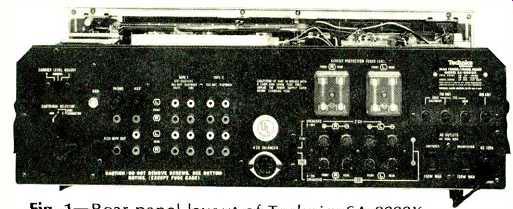
Fig. 1--Rear panel layout of Technics SA-8000X
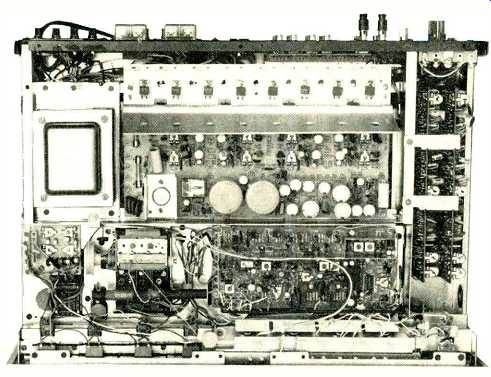
Fig. 2--Interior of SA-8000X
FM Measurements
Results of test measurements of the FM section of the SA-8000X are shown, in part, in Fig. 3. Although IHF sensitivity was higher than claimed (2.5 µV), 50 dB of quieting was reached with a signal input of only 4.9 microvolts.
Ultimate quieting in mono reached a maximum of 70 dB at all signal levels above 100 NV-considerably better than the 65 dB claimed by the manufacturer. Switchover to stereo occurred at about 8 microvolts, at which signal level noise was already down over 30 dB. Ultimate quieting in stereo reached 60 dB, a very respectable figure considering the fact that residual products then observed consisted of 38 kHz carrier leak-through rather than random noise.
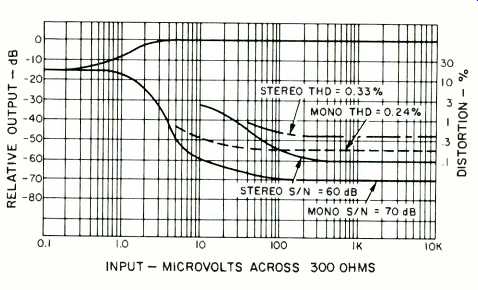
Fig. 3--FM quieting and distortion characteristics.
Technics claims carrier rejection of only 50 dB. THD in mono decreased to 0.24% for any signal level above 50 µV, at 1 kHz. In stereo, THD decreased to 0.33% with a 1 kHz signal for all input signal levels above 200 µV-again, considerably better than claimed. As shown' in F1g. 4, THD tends to rise at the high frequency end of the audio spectrum, reaching just under 1.0% at 10 kHz in mono, and slightly more than 2.0% in stereo at the same extreme frequency. In the case of the stereo THD readings at high frequencies, the meter is responding, in part, to low-level "beats" caused by the interaction of the high audio frequency and the residual 19 kHz and 38 kHz carrier products.
AM suppression measured exactly 50 dB as claimed, and capture ratio exceeded claims with measured readings of 1.3 dB for 100 µV signal levels. Selectivity measured 67 dB, a bit better than claimed.
Stereo FM separation at mid frequencies, also plotted in Fig. 4, measured 42 dB, decreasing to 26 dB at 10 kHz. At the low end, separation remained at 40 dB or better for all frequencies down to 50 Hz.
Amplifier Measurements
THD versus power for a 1 kHz input signal is plotted for both 4-channel and 2-channel strapped operation in Fig. 5.
In both modes, mid-band power output capability was in excess of manufacturer's claims, reaching 18 watts per channel and 48 watts per channel respectively, for rated THD of 0.5%. IM distortion, shown for the 4-channel mode only, tended to rise almost linearly for power levels above 5 watts per channel, but remained below rated value of 0.7% right up to rated output which is 13 watts under these conditions. The 13 watt per channel nominal output was used to measure distortion versus frequency which is plotted in Fig. 6. Under these conditions, the receiver delivers full power from 20 Hz to 20 kHz at less than rated distortion (0.5%).
Power bandwidth, graphed in Fig. 7, extends from 3 Hz to 50 kHz, substantially better than claimed. The measurements were based upon a rated output of 16 watts per channel. If 13 watts were used as a 0 dB reference, the power bandwidth would have extended even higher and lower.
Tone control and loudness compensation for a-30 dB volume control setting are shown in Fig. 8. Both conform closely to manufacturers specifications. There are no high frequency or low frequency filters in the receiver.
Our tests of CD-4 demodulator performance are necessarily based upon measurements using test records and CD-4 cartridges since, to date, no one has come up with a suitable piece of test equipment which can provide the complex signals equivalent to those recorded in the groove of a CD-4 record. Of late, we have been using a new individually calibrated MMC-6000 cartridge manufactured by Bang & Olufsen of Denmark. It is the best CD-4 cartridge we have tested to date and one of the few that can properly track Quadradiscs at tracking forces of 1 gram or less. Using this cartridge, the .CD-4 circuitry of the SA-8000X yielded separation of better than 22 dB from front to back, on both sides, and better than 28 dB from side to side, both front and back. Adjustment of the ideal demodulation parameters is accomplished in a matter of seconds, thanks to the four front panel meters on the unit, which are much easier to use in this procedure than simply listening to the test record and adjusting everything by ear, as the record's narration suggests. Carrier sensitivity of the demodulator circuitry was more than adequate for this, as well as for several other CD-4 cartridges that we tested in the course of our evaluations.
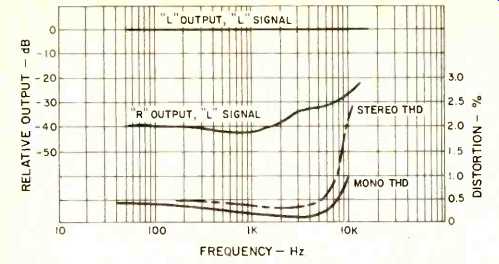
Fig. 4--Separation and distortion vs. frequency.

Fig. 5--THD and IM distortion characteristics.
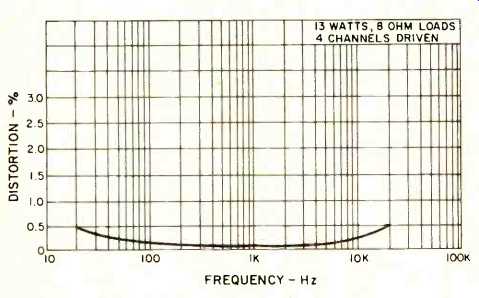
Fig. 6--Distortion vs. frequency.
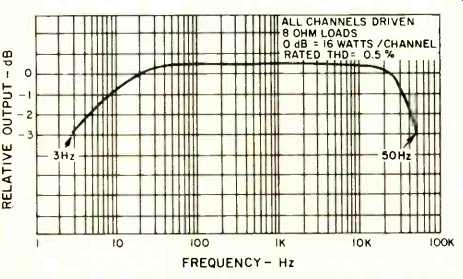
Fig. 7--Power bandwidth characteristics.
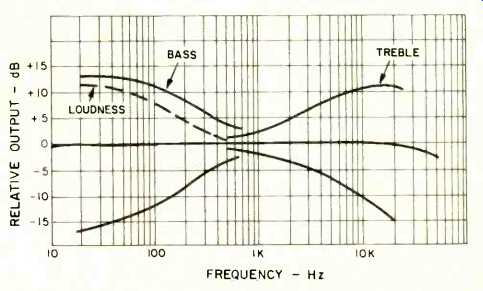
Fig. 8--Tone-control range and loudness characteristics.
FM performance of the receiver was good, with muting threshold sensibly adjusted for about 5 microvolts. Using the muting feature indirectly guarantees that any station received will be heard with a quieting of at least 50 dB just about enough for serious listening. Of course, the mute can be defeated if you want those few extra "noisy" signals from distant stations. The somewhat lower values of image and spurious rejection (compared to high priced stereo receivers) did not in any way interfere with our dial twirling and listening. The excellent capture ratio of the receiver did much to off-set the "average" AM suppression capability as far as multipath interference in stereo listening was concerned.
AM performance was adequate, but not outstanding typical of most present day medium and even higher priced integrated stereo and 4-channel receivers. The major design priorities of this set are obviously in the 4-channel area.
The wide-band power response of the SA-8000X helps to offset the fairly low audio power output obtainable in the 4-channel mode. With four reasonably efficient speakers in a good sized room, we had no trouble raising volume levels to fairly loud sound pressures. In the two-channel "strapped" mode, there's enough power for even the low efficiency systems some listeners prefer, but if you plan to purchase this set with 4-channel as your ultimate objective (even if you start out in stereo) it might be a good idea to audition the set in the four-channel mode and choose a pair of speakers that provide enough sound so that they can be duplicated when you add the extra pair for full 4-channel sound.
Matrix performance was also judged by a series of listening tests. The dual slide control which Technics calls AFD does, indeed, vary the spatial sound field and a variety of 4-channel effects can be created from both stereo and intentionally encoded 4-channel matrix discs.
The Phase Matrix 2 position on the AFD slide controls comes closest to properly decoding SQ encoded records and additional variation in sound placement and localization is achieved by selecting either the "0 phase" or "90° phase" positions on the mode switch, but all these variations did not provide the degree of apparent separation that either CD-4 records or matrix records played back through full-logic decoders can. In a musical context, however, this may not be all that important a consideration for the prospective listener who is not likely to walk around from speaker to speaker judging 4-channel crosstalk.
Technics by Panasonic introduced this model about a year ago and, based upon its features and overall performance, we would guess that the SA-8000X will continue to be a popular best-seller amongst that company's group of 4-channel audio products.
--Leonard Feldman
=================
(Adapted from Audio magazine, Nov. 1974)
Also see:
Technics SA-424 FM/AM Stereo Receiver (Aug. 1981)
Technics by Panasonic Quadraphonic Tape Recorder Model RS-740US (Equip. Profile, Jul. 1973)
= = = =